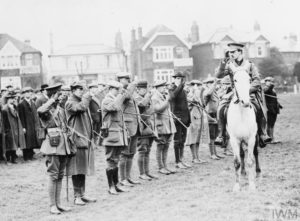Thursday July 25th, 1918
Eleventh day defaulters. Work all day on bombardment trenches. Mail up – one from home.
Saluting
The salute is in recognition of the King’s commission as worn by an officer on his shoulder, it is not for the man wearing it. Originally a soldier doffed his cap to the King’s commission but as headgear got more complicated through the centuries, the salute evolved.²

The style of the salute varies across countries and armed services. The British soldier has a standard way of saluting. Fingers together, palm facing out, fingertips touching the right temple. The longest way up and the shortest way down.
‘The right arm comes up in a wide arc, extended, out up the … side, and the hand opens as it comes up. You stop suddenly with the hand open, rigid, thumb and fingers parallel, hand in alignment with the forearm, palm open and facing outwards. The forefinger is more-or-less in line with the edge of the right eyebrow (do not salute bare-headed!). You stay like that for the count of “two, three”, and then snap your hand down the shortest way, brushing your tunic pocket button, hand closing in the process, back to the position of attention.’¹
It is a skill to be learnt and practised. As evidenced in this photograph of company officers of the 13th (Service) Battalion of the East Surrey Regiment (Wandsworth), saluting their Commanding Officer, Captain Webster at Thames Ditton in February 1915.*
Exceptions & Changes
A soldier should not salute if he is not wearing appropriate head gear – instead he should come to attention.
Which hand a soldier salutes with wasn’t fixed until July 1918 when Army Order 211 was issued. As described in the BWD today, it dictated that all ranks must salute with only the right hand. Up till now a soldier could salute with either hand, depending on which was further away from the officer being saluted.
Officers always salute with the right hand – as in theory their left had will be holding their scabbard. This despite the fact that officers had been instructed to dispense with swords in 1916.
While officers should also salute each other, this rule can be quite casually applied unless other ranks (more senior or junior) are present.
When the presence of an enemy sniper was suspected, saluting could be dangerous as it singled out superior officers. Consequently it could be suspended in certain circumstances. Otherwise, failure to salute a superior could leave a Tommy in hot water, faced with disciplinary action and extra fatigues.³
13th (Service) Battalion War Diary – 25th July 1918 – Haudricourt, France
Training and working parties. 5 NCO sent to Brigade PT and BE class. Army Order 211 of July 1918 received and published in orders ref all ranks saluting with right hand only. Lieut. G Iles (Quartermaster) and Capt EH Coyne RAMC proceeded on leave.
References & Further Reading
¹ How did the British Army salute in WWI? on Yahoo Answers
² ‘Salute’ on Wikipedia
³ ‘Military Crimes 1914-18‘ on the Long Long Trail
* Q 53632, copyright Imperial War Museums


